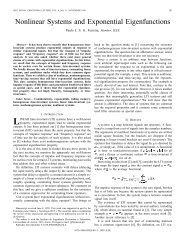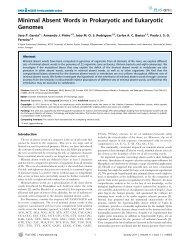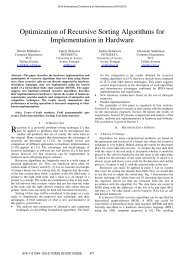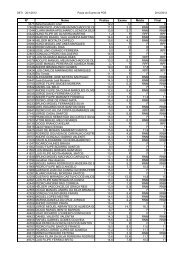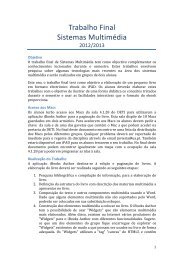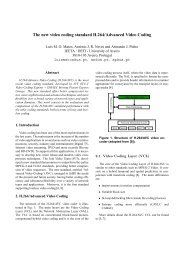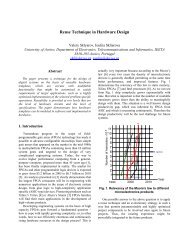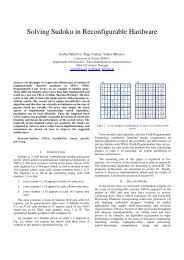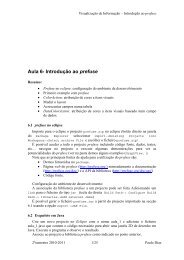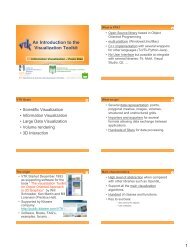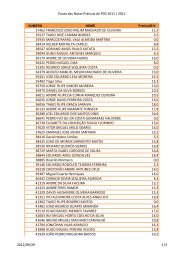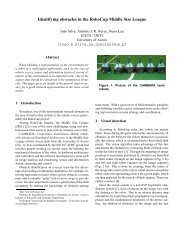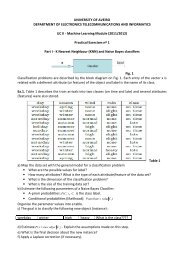DATA SHEET - IEETA
DATA SHEET - IEETA
DATA SHEET - IEETA
Create successful ePaper yourself
Turn your PDF publications into a flip-book with our unique Google optimized e-Paper software.
Philips Semiconductors Product specification<br />
8-bit microcontroller with on-chip CAN P8xC592<br />
13.5.16 AUTO ADDRESS INCREMENT<br />
With the Auto Address Increment mode a fast stack-like<br />
reading and writing of CAN-controller internal registers is<br />
provided. If the bit CANADR.5 (AutoInc) is HIGH, the<br />
content of CANADR is incremented automatically after any<br />
read or write access to CANDAT. For instance, loading a<br />
message into the Transmit Buffer can be done by writing<br />
2AH into CANADR and then moving byte by byte of the<br />
message to CANDAT. Incrementing CANADR beyond<br />
XX111111B resets the bit CANADR.5 (AutoInc)<br />
automatically (CANADR = XX000000B).<br />
13.5.17 HIGH SPEED DMA<br />
The DMA-logic allows you to transfer a complete message<br />
(up to 10 bytes) between CAN-controller and MAIN RAM<br />
in 2 instruction cycles at maximum; up to 4 bytes are<br />
transferred in 1 instruction cycle. The performance of the<br />
CPU is strongly enhanced because this very fast transfer<br />
is carried out in the background.<br />
A DMA transfer is achieved by first writing the RAM<br />
address (00H to FFH) into CANSTA and then setting the<br />
TX- or RX-Buffer address in CANDR and the bit<br />
CANADR.7 (DMA) simultaneously; the RAM address<br />
points to the location of the first byte to be transferred.<br />
Setting the DMA bit causes an automatic evaluation of the<br />
Data Length Code and then the transfer; for a TX-DMA<br />
transfer the Data Length Code is expected at the location<br />
‘RAM address +1’.<br />
In order to program a TX-DMA transfer the value 8AH<br />
(address 10) has to be written into CANADR. Then a<br />
complete message, consisting of the 2-byte Descriptor<br />
and the Data Field (0 to 8 bytes), starting at location<br />
‘RAM address’ is transferred to the TX-Buffer.<br />
The RX-DMA transfer is very versatile. By writing a value<br />
in the range of 94H (address 20) up to 9DH (address 29)<br />
into CANADR the whole or a part of the received message,<br />
starting at the specified address, is transferred to the<br />
internal Data Memory. This allows e.g. to transfer the bytes<br />
of the Data Field only.<br />
After a successful DMA transfer the DMA-bit is reset.<br />
During a DMA transfer the CPU can process the next<br />
instruction. However, an access to the Data Memory,<br />
1996 Jun 27 51<br />
CANADR, CANDAT, CANCON or CANSTA is not allowed.<br />
After having set the DMA-bit, every interrupt is disabled<br />
until the end of the transfer. Note, that disadvantageous<br />
programming may lead to an interrupt response time of at<br />
most 10 instruction cycles. The shortest interrupt response<br />
time is achieved by using 2 consecutive 1-cycle<br />
instructions directly after setting the DMA-bit.<br />
During the reset state (bit Reset Request is HIGH) a DMA<br />
transfer is not possible.<br />
13.5.18 BUS TIMING/SYNCHRONIZATION<br />
The Bus Timing Logic (BTL) monitors the serial bus-line<br />
via the on-chip input comparator and performs the<br />
following functions (see Section 13.4):<br />
• Monitors the serial bus-line level<br />
• Adjusts the sample point, within a bit period<br />
(programmable)<br />
• Samples the bus-line level using majority logic<br />
(programmable, 1 or 3 samples)<br />
• Synchronization to the bit stream:<br />
– hard synchronization at the start of a message<br />
– resynchronization during transfer of a message.<br />
The configuration of the BTL is performed during the<br />
initialization of the CAN-controller. The BTL uses the<br />
following three registers:<br />
• Control Register (Sync)<br />
• Bus Timing Register 0<br />
• Bus Timing Register 1.<br />
13.5.19 BIT TIMING<br />
A bit period is built up from a number of system clock<br />
cycles (tSCL), see Section 13.5.9.<br />
One bit period is the result of the addition of the<br />
programmable segments TSEG1 and TSEG2 and the<br />
general segment SYNCSEG.<br />
13.5.19.1 Synchronization Segment (SYNCSEG)<br />
The incoming edge of a bit is expected during this state;<br />
this state corresponds to one system clock cycle (1 × tSCL).



